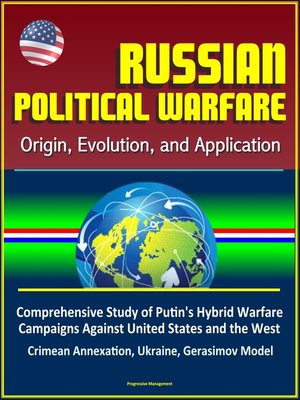Russian Political Warfare
ebook ∣ Origin, Evolution, and Application--Comprehensive Study of Putin's Hybrid Warfare Campaigns Against United States and the West, Crimean Annexation, Ukraine, Gerasimov Model
By Progressive Management

Sign up to save your library
With an OverDrive account, you can save your favorite libraries for at-a-glance information about availability. Find out more about OverDrive accounts.
Find this title in Libby, the library reading app by OverDrive.



Search for a digital library with this title
Title found at these libraries:
| Loading... |
This excellent report has been professionally converted for accurate flowing-text e-book format reproduction. Russia's annexation of the Crimean Peninsula in 2014 and subsequent activities in Eastern Ukraine are not isolated incidents, but rather a new form of hybrid war, or asymmetric warfare. They are part of a decades-long and continent-spanning Russian political warfare (PW) campaign. Analysis of the origin, history, and evolution of Soviet/Russian PW from 1917 through today reveals that Russia is using PW to assert regional dominance and challenge the unipolarity of the United States and the West. A review of events in Ukraine demonstrates Russia is using its latest evolution of PW doctrine, the Gerasimov Model, to achieve strategic objectives while remaining below the military response threshold of the international community. This paper combines an empirical and case study review of PW, with lessons from the Cold War, to propose a conceptual framework and a supporting model for foreign policy makers, planners, and practitioners to better understand PW. Furthermore, it recommends the United States adopt a proactive PW strategy to support national policy objectives and counter the PW activities of Russia and other rising powers. United States Special Operations Forces are well-suited for PW and will play a pivotal role in a U.S. PW strategy that encompasses all elements of national power and synchronizes the interagency community.
CHAPTER 1: INTRODUCTION: RUSSIAN POLITICAL WARFARE * CHAPTER II - POLITICAL WARFARE: ORIGINS AND IMPLEMENTATION * CHAPTER III - THE COLD WAR - PART I: SOVIET POLITICAL WARFARE 1947-1991 * CHAPTER IV - THE COLD WAR - PART II: U.S. POLITICAL WARFARE 1947-1991 * CHAPTER V - THE EVOLUTION OF RUSSIAN POLITICAL WARFARE 1991-2014 * CHAPTER VI - UKRAINE: RUSSIA'S CRISIS IN THE MAKING (1991-2013) * CHAPTER VII - RUSSIAN POLITICAL WARFARE: THE EVOLUTION OF THE GERASIMOV DOCTRINE AND ITS APPLICATION IN UKRAINE * CHAPTER VIII - HYPOTHESIS VALIDATION AND CONCLUSIONS * CHAPTER IX - OPERATIONAL CONCEPT: POLICY RECOMMENDATIONSAND ROLE OF USSOF
Russia's PW affects U.S. national interests in three ways: it threatens the North Atlantic Treaty Organization (NATO), it destabilizes the global security status quo, and demonstrates that constitutional democracies are vulnerable to PW strategies. NATO's members are guaranteed collective defense against armed aggression, but NATO members in Eastern Europe fear that Russia's current tactics can undermine their sovereignty and redraw their borders without triggering an armed NATO response. As the quintessential status-quo power, U.S. interests are at stake in maintaining the balance of power within, and respect for, the current international system of laws, regulations, and traditions.
Russia is demonstrating the effectiveness of using PW strategies to target constitutional democracies. If this trend is not reversed, then it will be repeated in other situations by different actors. America must successfully oppose Russian PW to prevent it from becoming the strategy of choice for emerging regional or global powers opposed to U.S. interests. A broader analysis of Russian PW origins, evolution, and current capacity is needed in order to provide U.S. foreign policy makers and executors with viable options to address it. General policy recommendations for U.S. PW are proposed, as well as specific policy recommendations to enable proactive U.S. PW and counter Russian PW. The policy recommendations are founded on the premise that the United States interagency community is well-structured to embrace PW. The Department of State and its country teams are ideal to take the lead on...






